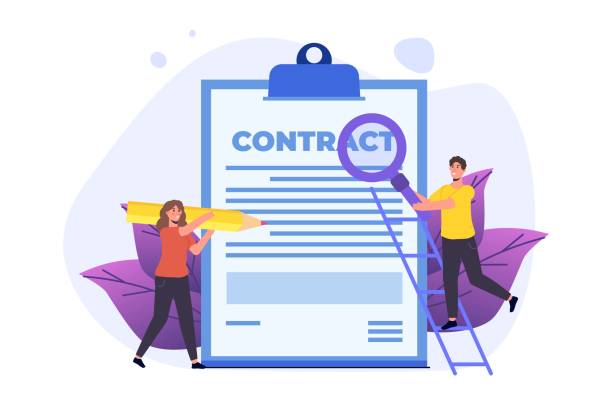Introduction to the Importance of #SecureWebsiteDesign and Upcoming Challenges

In today’s digital world, where businesses and individuals increasingly rely on the internet, secure website design is no longer an option, but an undeniable necessity.
Websites, serving as business showcases, communication tools, and platforms for financial transactions, are constantly targeted by cyber attacks.
Failure to adhere to security principles during design and development can lead to irreparable damage, including the loss of sensitive user data, identity theft, harm to brand reputation, and significant financial losses.
This section explains the fundamental importance of web security and introduces some of the main challenges faced by website developers and administrators.
How can we ensure that user data is safe and the website is resilient against growing threats? This fundamental question requires a specialized and comprehensive approach to cybersecurity.
The main goal of this article is to provide an educational and comprehensive guide to achieving maximum security in the web space.
Do not forget that any negligence in #cybersecurity can lead to an irreparable disaster and destroy a brand’s reputation forever.
Are you tired of your e-commerce site having visitors but no sales? RasaWeb solves your main problem with professional e-commerce website design!
✅ Significant sales increase with targeted design
✅ Flawless user experience for your customers
⚡ Get free consultation!
Basic Principles of Secure Website Design and Layered Architecture

Secure website design requires adherence to a set of specific principles and architectures that fundamentally ensure the strength and resilience of the website.
The first step in this regard is adopting the concept of “Security by Design”; meaning that security considerations must be an integral part of the process from the very initial stages of project planning and design, not an afterthought.
This educational approach emphasizes the importance of analyzing potential risks, threats, and vulnerabilities before writing even a single line of code.
Implementing a layered architecture is another key principle that, by creating multiple defensive layers, prevents attackers from easily accessing sensitive parts of the system.
These layers can include Web Application Firewalls (WAF), Intrusion Detection and Prevention Systems (IDS/IPS), data encryption during transit and storage, and precise access control.
Did you know that many security breaches occur due to the lack of a strong security architecture? This is a thought-provoking content that highlights the importance of investing in specialized knowledge.
Adhering to these basic principles is the cornerstone of powerful and resilient website design against cyber attacks.
Furthermore, using secure development frameworks and continuous updating of libraries and packages used are among the important recommendations in this area.
SSL/TLS Certificates and Their Vital Role in Secure Website Design

One of the most important pillars in secure website design is the use of SSL/TLS certificates.
These certificates are protocols that encrypt the communication between the user’s browser and the website server, preventing eavesdropping, tampering, or forging of information during transit.
In fact, SSL/TLS ensures that data, such as login information, credit card details, and other personal data, is securely transmitted from the user’s computer to the server.
This section explains the types of SSL/TLS certificates and how they work.
Common certificates include Domain Validation (DV), Organization Validation (OV), and Extended Validation (EV) certificates, each offering a different level of trust and credibility.
Did you know that Google penalizes websites without SSL in its search results? This is important news that demonstrates the high importance of SSL for SEO and user trust.
Proper implementation of SSL/TLS is a fundamental and indispensable step on the path to your website’s security.
Without this layer of protection, your users’ information is at serious risk.
| Certificate Type | Validation Level | Suitable for | Approximate Issuance Time |
|---|---|---|---|
| DV (Domain Validation) | Only domain ownership verification | Blogs, personal sites, small sites | Few minutes |
| OV (Organization Validation) | Organization and domain verification | Companies, medium business websites | Few days |
| EV (Extended Validation) | Highest level of organization, identity, and domain verification | Banks, large online stores, sensitive websites | Few weeks |
| Wildcard SSL | Domain and all subdomains validation | Companies with multiple subdomains | Depends on validation type (DV/OV/EV) |
Countering Common Cyber Attacks in Secure Website Design

Cyber attacks are an inseparable part of the web landscape, and for achieving secure website design, understanding and countering them is of paramount importance.
This section educates on the most common types of attacks and provides guidance for preventing them during website development and maintenance.
Attacks such as SQL Injection, which aims to inject malicious code into the database, XSS (Cross-Site Scripting), which allows the injection of client-side scripts, and CSRF (Cross-Site Request Forgery), which enables attackers to perform unwanted actions on behalf of authenticated users, are all considered serious threats.
Analyzing these attacks and understanding their mechanisms helps developers write their code more securely.
For example, using parameterized queries to prevent SQL Injection, strict user input validation to counter XSS, and employing anti-CSRF tokens are among the specialized solutions to enhance security.
Are all developers aware of these principles? This is thought-provoking content that indicates the increasing need for continuous education in web security.
Proper implementation of these solutions can significantly reduce the risk of website vulnerability and greatly contribute to your website’s security against threats.
Are you dissatisfied with the low sales of your e-commerce site?
RasaWeb is your solution for a professional and high-selling e-commerce website.
✅ Significant increase in sales and revenue
✅ Easy and enjoyable shopping experience for customers
⚡ Get free consultation from RasaWeb now!
Password Management and Strong Authentication in Secure Website Design

Many cyber attacks originate from weaknesses in password management and authentication systems.
Therefore, one of the most important aspects of secure website design is implementing strong mechanisms for user authentication.
This section provides key guidelines for creating strong passwords, securely storing them, and using Multi-Factor Authentication (MFA).
Websites should encourage users to use complex passwords (including uppercase and lowercase letters, numbers, and symbols) and utilize strong hashing protocols like bcrypt or Argon2 for storing passwords in the database, instead of storing them as plain text.
This is a specialized approach that is vital in protecting user information.
MFA, which requires two or more factors to verify user identity (such as something the user knows, something the user has, or something the user is), adds a significant security layer, making attacker access difficult even if a password is compromised.
Have you ever wondered why some of the largest companies still face password-related security breaches? This is thought-provoking content that shows how difficult, yet vital, the proper implementation of these mechanisms is.
Enhancing the security of the authentication system is an important step towards increasing website security.
Continuous Updates and Security Monitoring in Secure Website Design

After secure website design and initial implementation, the work does not end.
The cyber threat landscape is constantly evolving, and continuous maintenance and updates are critically important.
This section explains the importance of software updates and security monitoring systems.
All components of the website, from server operating systems and web servers to programming languages, frameworks, libraries, plugins, and even Content Management Systems (CMS), must be regularly updated to address known vulnerabilities.
This is a continuous educational process that the development team must adhere to.
Furthermore, implementing security monitoring systems (like SIEM) and Intrusion Detection Systems (IDS) can help identify suspicious activities and attacks in real time.
This specialized approach allows for rapid response to threats.
Are you aware of the latest reported vulnerabilities in the software you use? This is thought-provoking content that demonstrates the importance of following news on security developments.
With active monitoring and rapid response, a small security incident can be prevented from turning into a major disaster, thus ensuring the stability of web application security.
Regular Backup and Disaster Recovery: The Backbone of Secure Website Design

Even with the best secure website design approaches and the strongest defensive mechanisms, no website is 100% immune to attacks or system failures.
Therefore, regular backups and having a comprehensive Disaster Recovery Plan (DRP) are of critical importance.
This section provides guidance and explanation on the importance and methods of implementing these two key aspects in maintaining business continuity.
Backups should include all website files, databases, and server configurations, and be maintained in multiple secure locations (such as cloud storage and offline storage).
Disaster recovery planning also involves defining specific procedures for restoring the system to an operational state after a major incident (such as a ransomware attack, widespread hardware failure, or natural disasters).
Do you know how quickly your website can return to normal operation if data is suddenly lost? This is thought-provoking content that highlights the necessity of continuous testing of backup and recovery plans.
Lack of a DRP can lead to permanent data loss and prolonged service downtime, resulting in irreparable financial and reputational damages.
Backups and disaster recovery planning are your last line of defense.
| Backup Type | Description | Advantages | Disadvantages |
|---|---|---|---|
| Full Backup | A complete copy of all data in each backup. | Fastest recovery time, simplest method. | Requires a lot of space, time-consuming. |
| Incremental Backup | Only data that has changed since the last backup (full or incremental) is copied. | Saves space and time. | More complex and slower recovery. |
| Differential Backup | Only data that has changed since the last full backup is copied. | Faster recovery than incremental, less space than full. | Grows larger over time. |
Database Security in Secure Website Design

The database is the heart of any website, where all sensitive and critical information is stored.
Therefore, database security is a key component in secure website design.
This section specializes and educates on methods and best practices for database protection.
The first step is implementing the Principle of Least Privilege; meaning that users and applications should only have access to the information and functions necessary for their tasks.
Using a Database Firewall and encrypting data at rest and data in transit are other vital measures.
Furthermore, regular monitoring of database activities is essential to identify any unauthorized access or suspicious behavior.
Did you know that many major security breaches occur through database vulnerabilities? This is thought-provoking content that highlights the importance of investing in database security.
Regularly updating the Database Management System (DBMS), disabling default ports, and changing default passwords are also important guidelines in this area.
A secure and protected database is the backbone of a secure website.
Does your company’s website perform as well as your brand deserves? In today’s competitive world, your website is your most important online tool. RasaWeb, specializing in professional corporate website design, helps you to:
✅ Build customer credibility and trust
✅ Convert website visitors into customers
⚡ Get a free consultation!
Challenges and Future of Web Security: A Vision for Secure Website Design

The world of cybersecurity is constantly evolving, and with the emergence of new technologies, new challenges arise for secure website design.
This section analytically and with a thought-provoking content approach, examines the challenges facing web security and its future outlook.
With the increasing use of artificial intelligence and machine learning, both defensive and offensive tools are becoming more advanced.
Can attackers use AI to discover vulnerabilities and carry out more sophisticated attacks? This is a question that occupies the security community.
The security of the Internet of Things (IoT) and Web 3.0 has also created new challenges in the field of secure website design, requiring innovative solutions.
Furthermore, the rise of ransomware attacks and Advanced Persistent Threats (APTs) indicates that websites must be prepared to counter more complex threats.
The good news is that cybersecurity experts are also developing new tools and methods to combat these threats.
These methods include using blockchain to enhance transparency and security, as well as developing AI-based intrusion detection systems.
Awareness of these challenges and future trends helps organizations keep their cybersecurity strategies up-to-date and be pioneers in secure website design.
The User’s Role and Shared Responsibilities in Secure Website Design

Despite all the specialized measures and complex actions taken for secure website design, the role of users in maintaining the overall security of the web ecosystem is undeniable.
Web security is a shared responsibility, with both website developers, administrators, and users participating in it.
This section provides guidance and a fun approach to tips that users can follow to enhance their own security and, consequently, the overall security of websites.
Did you know that the weakest link in the security chain is often the user themselves? This is thought-provoking content that highlights the importance of user education.
Using strong and unique passwords for each website, enabling two-factor authentication, being cautious when clicking on unknown links or downloading files from untrusted sources, and keeping browsers and operating systems updated are all essential measures.
Educating users about phishing and social engineering threats is also crucial.
Ultimately, even the most secure castle will fall if its gates are opened by its guardians.
Active user participation in adhering to basic security principles significantly helps increase the resilience of websites against attacks and makes the online environment safer for everyone.
Frequently Asked Questions
| Row | Question | Answer |
|---|---|---|
| 1 | What is secure website design? | Secure website design is a process in which websites are built with security measures taken into account from the initial stages of development to protect against cyber attacks, unauthorized access, and data loss. |
| 2 | Why is secure website design important? | Website security is vital for maintaining user trust, protecting sensitive information (personal and financial), preventing damage to brand reputation, and complying with privacy and security regulations (such as GDPR). A security breach can lead to financial and legal damages. |
| 3 | What are the most common cyber attacks a website faces? | Some of the most common attacks include SQL Injection, Cross-Site Scripting (XSS), Distributed Denial of Service (DDoS), Brute Force, and credential-stuffing attacks. |
| 4 | What is SQL Injection and how to prevent it? | SQL Injection is an attack where the attacker attempts to manipulate the database or extract information by injecting malicious SQL code into site inputs. To prevent it, one should use Prepared Statements/Parameterized Queries, ORM (Object-Relational Mapping), and strict input validation. |
| 5 | What is Cross-Site Scripting (XSS)? | XSS is an attack where the attacker injects malicious scripts (usually JavaScript) into web pages, which are then executed by other users’ browsers. This can lead to cookie theft, session information theft, or alteration of the website’s appearance. |
| 6 | How can Brute Force attacks on login pages be prevented? | To prevent Brute Force attacks, CAPTCHA, account lockout (limiting the number of failed login attempts), two-factor authentication (2FA), and using complex and long passwords should be employed. |
| 7 | What is the role of HTTPS in website security? | HTTPS encrypts the communication between the user’s browser and the website server using SSL/TLS. This prevents eavesdropping, tampering, or forging of information during transit and increases user trust. |
| 8 | What is the importance of Input Validation in security? | Input validation is the process of checking and sanitizing data entered by the user. This prevents the injection of malicious code, XSS, SQL Injection attacks, and other vulnerabilities, ensuring that the data conforms to the expected format. |
| 9 | Why is regular updating of systems and website software necessary? | Regular updates of the operating system, CMS (like WordPress), plugins, themes, and libraries used fix known security vulnerabilities. Hackers often exploit weaknesses in outdated software to infiltrate. |
| 10 | What role does regular backup play in secure website design? | Regular and tested backups of website data (database and files) are a vital layer of defense against data loss due to cyber attacks, human errors, or hardware failures. This allows for quick website recovery in case of a disaster. |
And other services of RasaWeb Advertising Agency in the field of advertising
Smart Link Building: An innovative platform for improving customer behavior analysis with precise audience targeting.
Smart Content Strategy: A new service to enhance SEO ranking improvement through the use of real data.
Smart Google Ads: A combination of creativity and technology to increase click-through rates through custom programming.
Smart Marketplace: A professional solution for improving SEO ranking with a focus on customizing user experience.
Smart Marketing Automation: A new service to increase customer acquisition through SEO-driven content strategy.
And over hundreds of other services in internet advertising, advertising consultation, and organizational solutions
Internet Advertising | Advertising Strategy | Advertorial
Sources
Solutions for increasing website security
Importance of SSL Certificate in website security
Security Checklist for Your Website
Key tips for website security
✔️ RasaWeb Afarin, a leading digital marketing agency, paves the way for your business success. From professional e-commerce website design to comprehensive SEO strategies, we are ready to distinguish your brand in the online space and elevate it to its peak.
📍 Tehran, Mirdamad Street, next to Bank Markazi, Southern Kazeroun Alley, Ramin Alley, No. 6


